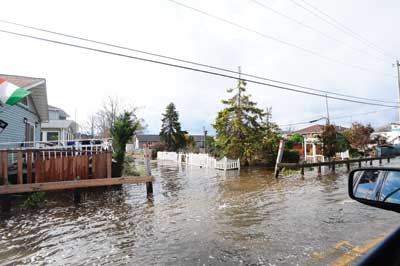 |
| (1) Water was still present in the streets on the west end of the Rockaway Peninsula two full days after Sandy’s surge. At the height of the surge, this street was under almost seven feet of water. (Photos courtesy of the Fire Department of New York.) |
BY ROBERT MAYNES
On October 29, 2012, New York City (NYC), Long Island, Connecticut, and New Jersey were struck by superstorm Sandy with catastrophic results. In NYC, most residents in the predicted inundation area did not believe a storm in late October could produce a deadly surge of ocean water flooding multiple residential and commercial neighborhoods. In 2011, Hurricane Irene struck during early September with an impact far below what was predicted. Many families that relocated during Sandy believed “the boy was crying wolf, again.” Many NYC agencies failed to predict or comprehend the catastrophic potential and impact from Sandy. For the week preceding October 28, meteorologists continuously reported progress of the storm with Sandy reaching another ominous trigger point each day. Sandy was on path to cause the destruction predicted in The Weather Channel’s documentary It Could Happen Tomorrow. The Fire Department of New York (FDNY) did recognize Sandy’s potential and did prepare for the storm based on experiences from Hurricanes Katrina, Rita, and Gustav. Additionally, FDNY’s Incident Management Team (IMT) created in 2006 a complex simulation exercise titled “Hurricane Noreen,” which simulated hurricane incidents in the Rockaway Peninsula and Coney Island that were hauntingly accurate in 2012. Based on this preparation and established disaster policies and procedures developed after the World Trade Center (WTC) terrorist attack, FDNY successfully met challenges before, during, and after the storm.
Hurricane Katrina produced a 28-foot surge that severely impacted Louisiana, Mississippi, and Alabama. The surge also damaged the levees protecting New Orleans, allowing the majority of the city to flood. The resulting damage in New Orleans was similar to the damage produced by a surge, but it took longer to develop and longer to recede. Hurricane Irene struck the East Coast and proceeded inland, causing catastrophic flood damage to New Jersey, Pennsylvania, and particularly the Catskill Mountains of New York State. NYC was impacted by wind damage and moderate flooding, but they were far short of earlier predictions. Hurricane Irene hit NYC on August 29, 2011, when the water temperatures off Long Island were at their historic highest, reported at 74°F. Mayor Bloomberg had ordered a mandatory evacuation of the Rockaway Peninsula and other identified areas vulnerable to storm surge. The resulting minor surge created an inaccurate but prevalent sentiment that New York would never receive a fatal surge. Sandy made landfall a year and two months later in 2012 when the water temperature was 11°F cooler, which should significantly have reduced the storm’s strength. The water temperature most likely reduced the storm’s strength but not before it produced a 14-foot surge over the south shores of four NYC boroughs.
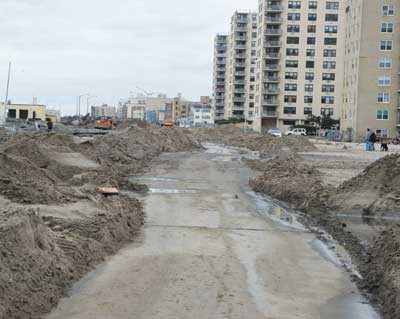 |
| (2) The impact of the sand dumped on Rockaway as a result of the storm surge. Interagency task forces consisting of an FDNY task force leader, four engine companies, sanitation resources, and Department of Environmental Protection resources cleared more than 400 blocks before weather terminated operations at the year’s end. (3) This commercial building on Rockaway Beach Boulevard at Beach 114th Street was damaged by fire. Firefighters from Engine 268 and Ladder 137 drove up to this fire while relocating from quarters on Beach 116th Street. After they started operations, surge water from the ocean, only 800 feet to the south, rose to six feet and stalled the apparatus and severely threatened the firefighters. Civilians trapped by the rapidly expanding fire were rescued by the members and firefighters from Swift Water 2. Hours later, as the water receded below Engine 268’s exhaust, the apparatus started, and suppression efforts stopped the fire after it had destroyed 21 buildings. |
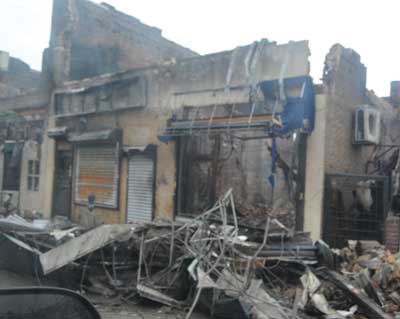 |
Meteorologists warn that many different factors impact storm surge severity including the moon phase, the tide at impact, the geographic area to the eye of the storm, wind speed, and water temperature. Sandy struck NYC as the tide was flooding toward high tide, during a full moon, with deadly wind speeds and gusts, and the eye striking New Jersey. All of these factors increase a storm’s impact. NYC lies in a right angle of the Atlantic Ocean with downtown Manhattan, the south shore of Staten Island, the Coney Island region of Brooklyn, and the entire Rockaway Peninsula of Queens vulnerable to a storm surge moving up the Atlantic Coast. With Sandy’s eye striking to the west of NYC, the threatened boroughs would receive reduced rain but increased wind and storm surge. Combined with all these factors, Sandy had the ingredients for a deadly storm with massive financial impact. Sandy struck and sent a surge 14 feet over the high tide mark of Rockaway’s beaches. A 14-foot storm surge can be defined by calculating the high tide mark and raising a 14-foot plumb column and attaching a laser transit to the top. The water will reach wherever the laser line strikes. If Sandy had struck New York City with the water temperature that was present during Hurricane Irene, the results would have been catastrophic to human life. The surge would have had the potential for a 22-foot height. All victims trapped up to their chests would have been subjected to surging water significantly over their heads.
For the Rockaway Peninsula, all areas from Beach 32nd Street in Far Rockaway past Beach 220th Street in Breezy Point would succumb to flood waters with a significant current approximately five to seven feet above the crown of the street. Additionally, Sandy would flood across Jamaica Bay with equal intensity and flood Southern Queens and Brooklyn, destroying the neighborhoods of Howard Beach, Broad Channel, West Hamilton Beach, Mill Basin, Canarsie, and Gerritsen Beach. Coney Island, Staten Island, and southern Manhattan were struck with similar intensity. Many of the stated neighborhoods were not accurately identified in the evacuation plan, causing additional personal and financial consequences.
 |
| (4) This photo illustrates the typical damage inflicted on South Queens residents. In addition to the damage caused by the surge, buildings were impacted by floating debris that included buildings dislodged from their foundations, vehicles, boats, boardwalks, decks, and sand. |
On the Rockaway Peninsula, almost nine miles of residences and businesses were under a storm surge whose depth prevented the use of any type of first response vehicle without amphibious capability. Any vehicles not moved prior to the storm were destroyed by salt water attacking the engine, transmission, and electrical parts. Traditional fire engines, ladders, support vehicles, and ambulances remaining in the area risked permanent damage. Meteorologists incorrectly reported that the surge would come in and quickly recede. Sandy’s surge did not recede for hours; the communities of Belle Harbor and Nesposit, located in the Beach 130s and 140s, suffered from three to four feet of surge water at low tide at approximately 0300 hours, eight to nine hours after the initial surge. FDNY prepared for this disaster by creating a plan with three parts: prestorm preparation, storm operations, and poststorm operations. The following is a synopsis of the FDNY operations in the Borough of Queens.
QUEENS BOROUGH
Background
Based on recommendations from the McKinsey report Increasing FDNY’s Preparedness, the FDNY instituted numerous policies focused on preparation for a disaster with WTC complexity. One of many changes was the creation of five borough commands with the ability to support and operate within a single borough with limited traditional support. FDNY Chief of Operations James Esposito completely empowered his borough commanders to take all actions and make all decisions necessary to fulfill FDNY’s mission statement. The McKinsey report recommended creating an IMT similar to the national IMTs that supported FDNY with the focus on urban disaster. The FDNY IMT was activated days before Sandy’s impact and supported all boroughs including Queens. The FDNY IMT incident commander (IC) started an assignment as Queens borough commander on September 1, 2012. Two deputy ICs, James Manahan and James Kane, assumed the role of IC while the original IC remained in Queens. Numerous additional improvements, particularly in the Special Operations Command (SOC), proved invaluable during Sandy, including task forces that had the qualifications and equipment to operate in swift water.
Prestorm
Individuals assigned to the FDNY IMT and the FDNY SOC task force had valuable hurricane response experience from Hurricanes Katrina, Rita, Gustav, Lee, and Irene. Individuals responding to these incidents were all cognizant of NYC’s vulnerability to a hurricane and prepared with intensity. In 2006, the FDNY IMT in cooperation with the U.S. Forestry Service (USFS) and the U.S. Coast Guard created a complex simulation for command and general staff candidates named “Hurricane Noreen.” The FDNY exercise developers performed extensive research and produced the simulation drill depicting a Category 2 hurricane impacting the Rockaway Peninsula. The simulation was created using the complexity found in the current simulation required for passing S-420, the course required for qualifying as a command and general staff member on a Type 2 IMT. USFS leadership approved Hurricane Noreen as an S-420 simulation. The research and lessons learned proved prophetic six years later, as most of the complexity and challenges described in Noreen were present during Sandy. FDNY individuals and teams used much of the research conducted for the simulation successfully during both Irene and Sandy. The activation and use of the FDNY IMT during Irene prepared the team for Sandy.
The FDNY IMT was activated on October 27 to support the buildup of FDNY resources and storm preparation. The IMT produced an incident action plan (IAP) for citywide response that included all additional and special units with their assignments. The IAP successfully informed all individuals of the units assigned, leaders’ names, equipment carried, communication ability, reporting time, and emergency procedures. As needs were identified, the IMT supported FDNY operations in all support activities from logistics to safety. FDNY operations started 24/7 full staffing on October 27.
Similarly, all five borough commands, which normally are closed on weekends, were staffed and augmented for the weekend prior to the storm. In Queens, the borough command prepared for severe surge damage to the south from the Atlantic Ocean and the north from Long Island Sound. Queens is divided into two divisions: the 13th Division in the south and the 14th Division in the north. In the 13th Division, a fifth battalion was created, Battalion 74, which was to augment Battalion 47 on the Rockaway Peninsula. Additionally, a Type 6 engine, locally called a brush fire unit, was staffed to move emergency medical services (EMS) resources into flooded areas, as well as two engine companies, one ladder company, and two swift water rescue teams. Each swift water team consisted of one officer, four firefighters, and two rescue boats; all personnel were equipped with cold water suits.
Queens anticipated complex down tree operations. FDNY is assigned tree operations as a core competency for life-saving operations, to clear roads and to provide access to structures. In anticipation of numerous tree assignments, we identified task forces consisting of smaller, rapid response vehicles. Each task force originated with two to four units and a task force leader. Each unit would have two firefighters serving as sawyer teams with additional chain saws, equipment, and chain saw personal protective equipment (PPE). The task forces were not activated until the heavy winds subsided.
Storm
The tide on the morning of the October 29 was abnormally high, which alerted all responders that the next high tide, at 1959 hours, had the potential for significant damage. At approximately 1900 hours, the surge swept over the Rockaway Peninsula. All units had moved according to the evacuation plan at 1800 hours with the exception of Engine 268 and Ladder 137 stationed on Beach 116th Street. Ladder 137’s apparatus failed to start and could not be fixed. The members were in the process of removing all equipment from the ladder while waiting for a spare apparatus from the mainland. All members of both units loaded Engine 268 to race the flooding ocean to the staging area on Beach 20th Street. The engine company responded to the call for a structural fire two blocks from quarters and arrived at a significant fire on Beach 114th Street and Rockaway Beach Boulevard as the surge water flooded to seven feet, stalling the apparatus. Lieutenant Kevin O’Connor transmitted the working fire and reported that the engine would not start because of the floodwater and could not pump water.
The situation for Queens leadership at 2100 hours was as follows.
- The surge water had flooded the Rockaway Peninsula and the neighborhoods of Howard Beach, West Hamilton Beach, and Broad Channel with an average of six feet of water.
- Approximately 21,000 buildings of mixed occupancy had been impacted.
- An incident command post (ICP) had been established on 156th Avenue and Cross Bay Boulevard, 400 yards south of the Belt Parkway.
- There was a confirmed fire extending to numerous buildings on Beach 114th Street; an engine company and ladder company were on the scene with inoperable apparatus. The engine could not pump water. They were augmented by a swift water team; all personnel were rescuing civilians from fire buildings and threatened buildings in the path of the fire.
Fires
A fire was visible two blocks from the fire’s edge in Howard Beach, and there was a report of numerous civilians trapped by extending fire. The Queens dispatcher reported that off-duty members were reporting two additional fires in Rockaway, one on Beach 130th Street and another in Breezy Point; both fires were rapidly extending as the result of high winds, with gusts reported to be higher than 90 miles per hour (mph).
Cross Bay Boulevard is the middle route of three routes to Rockaway with a bridge that enters the Peninsula at Beach 98th Street. This route was impassable, as were the routes through Far Rockaway to the east and the Marine Parkway Bridge to the west. The battalion chiefs who moved to Far Rockaway with the suppression units reported all routes to the Peninsula were blocked by a breach from ocean to bay at Beach 32nd Street. The water had not receded as experts reported it would. What was the strategy to attack the fires?
The plan devised was a three-pronged attack while maintaining communications and using the best route to the fire operations once it was determined. The Queens dispatcher was directed to create numerous task forces comprised of a battalion chief as task force leader, three engines, and one ladder. Once the water receded to approximately four feet, the task forces would attempt to push through the water and make stops similar to making a stop at a wildland fire. At 2153 hours, as the task forces were being assembled, a second alarm was transmitted in the unflooded area within the 13th Division for a wind-blown fire in a private dwelling extending to two exposures. The need for resources at the second alarm depleted the task forces for response to the Rockaway fires.
The swift water team, a marine unit, and a squad company were all ferrying victims from the Howard Beach fire and other flooding structures to the unflooded area. A large payloader was procured from the Sanitation Department. Battalion Chief (BC) George Healy and members from Ladder 155 entered the payloader and drove to the fire area; numerous times, they used the bucket of the payloader to remove victims to safety near the command post.
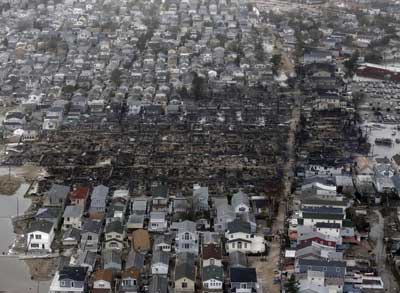 |
| (5) An aerial view of the damage from the Breezy Point fire. The fire started on the ocean side (the left of the photo) and was blown by hurricane winds to the west and then to the north. Firefighters stopped the fire and saved numerous homes only after losing 111 buildings. Approximately 20 percent of the community sustained catastrophic damage from fire and flooding. Almost all homes sustained significant damage. |
At this time, 2215 hours, the Howard Beach fire was not extending to additional buildings; the wind was blowing the fire to a vacant lot. The Rockaway Peninsula was not accessible; all Rockaway fires were reported to be gaining in intensity and extending to numerous buildings. There were scattered reports of civilians trapped. However, the water on Beach 114th Street had receded enough for Engine 268 to start the pumper and initiate suppression efforts. Chief James DiDomenico was assigned to gain access by way of the Peninsula. Chief Joseph Pfeiffer was to use the Marine Parkway Bridge for access into the Breezy Point fire. I would attack by way of Cross Bay Boulevard to focus on the Belle Harbor fire on Beach 129th, 130th, and 131st Streets.
The Marine Parkway Bridge permitted access first; the water near Breezy Point was receding to a level that permitted apparatus access. I led my task force to Belle Harbor using the same Marine Parkway route. Units started suppression efforts on the Breezy Point fire. Eventually, a sixth alarm was needed to suppress the Breezy Point fire. Only resourcefulness and ingenuity permitted the units to stop total loss of the neighborhood. In Breezy Point, fire destroyed 111 buildings.
The units assigned to Belle Harbor by way of the Marine Parkway Bridge were stopped by high water one mile from the fire. Numerous apparatus were stalled in the high water as units attempted to reach the fire by different routes. It was decided to use Engine 255 as a scout unit because the engines had higher clearance and a firefighter lived in the area and knew the high spots. Engine 255 barely made access, and I directed all units to wait for the water to recede another six inches. Water was reaching the windshield; firefighters riding in the back had water rise close to their knees.
Minutes before the access from the west, Battalion 47 and Battalion 74 accessed Belle Harbor from the east, Far Rockaway. Both battalions and the majority of the task force were directed to Belle Harbor because of the report that numerous civilians were trapped. Most of the trapped civilians were rescued by off-duty FDNY individuals who lived on the block. The three chief officers decided to stop the fire on Beach 130th Street at 444 on the east side and 447 on the west side. Firefighters augmented by off-duty FDNY individuals held their breath and hooked up to hydrants that were underwater and attacked the fires while wading through three feet of water. Numerous Battalion 47 units augmented by arriving mainland units stretched lines through backyards and down the street and successfully stopped the fire extension midblock despite numerous fully involved buildings whose fire was being pushed by 80-mph winds. Twenty-seven buildings were destroyed by fire, including the Harbor Light neighborhood restaurant, a foundation of Belle Harbor. The stop midblock on Beach 130th Street saved a minimum of 60 private dwellings in the wind-blown fire’s path.
Once the fire stop was initiated and progress was made on suppression, BC Viglietta transitioned to IC of the Beach 114th Street fire. Engine 268, Ladder 137, and Swift Water 2 were now augmented by arriving units from Battalion 47 and the mainland. The team successfully stopped the fire at 115-010 after losing 21 buildings to fire and saved approximately 50 civilians from the expanding fire.
Once the five significant fires were brought under control, a search-and-rescue mission was initiated in Howard Beach using the existing ICP. FDNY units started the mission and were augmented over three days by the FDNY SOC task force and three national Type 1 search and rescue task forces from Maryland, Pennsylvania, and Virginia. The FDNY IMT transitioned to the mission of supporting and organizing the search and rescue operation and completed searching more than 20,000 buildings in fewer than four days.
Poststorm
Based on the experiences from the previous hurricanes and a 2010 tornado, FDNY applied past lessons learned to organize the poststorm operations. The borough commanders continued to supervise their individual boroughs. The FDNY IMT was assigned to support borough activities, particularly logistics support.
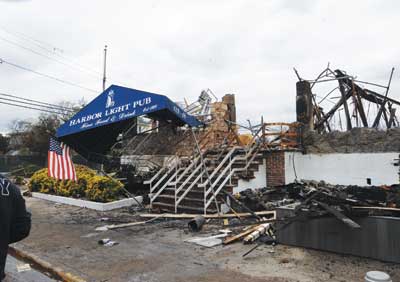 |
| (6) A view of the Harbor Light Restaurant (with awning) from Newport Avenue and (7) of its fire escape from Beach 130th Street. The Harbor Light served as a foundation for the residents of Belle Harbor and adjoining neighborhoods. It was near the middle of the rapidly extending fire. FDNY units stopped the fire midblock between Newport and Cronston Avenues. |
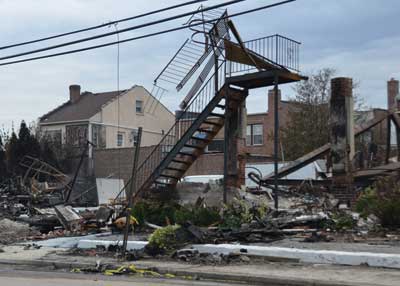 |
In Queens, three distinct operations were identified. The first was tree removal operations as per FDNY’s core competency. The second was dewatering operations, supporting impacted civilians and homeowners by pumping out basements and other emergency areas. Task forces were established and reported to the Queens Borough Command before sunrise for a briefing and logistical supplies. The operation’s organization changed numerous times, but the foundation was a branch in the surge-impacted area and a second branch out of the surge-impacted area. Task forces were assembled using numerous resources with individual task force consistency change daily. Task forces ranged from two units up to seven-plus units and as many as 40 individuals. The assignment and priority of each operational period was incident specific and necessitated flexibility and continuous updating. An additional task-specific task force was created; it reported directly to Engine 329, the FDNY engine assigned to protect Breezy Point and the west end of the Rockaway Peninsula. The fire suppression task force was established to protect Breezy Point, which received catastrophic infrastructure damage including a majority of the hydrant system.
The task forces were assembled by using four components: special units created for the operation, regular FDNY units assigned to the task force, units from SOC, and units from the Bureau of Training.
Rapid Response Vehicle Task Forces
Queens used the existing procedure to create 25 Rapid Response Vehicle (RRV) task forces. An RRV is a “bread truck”-type apparatus assigned to SOC support ladder companies. The RRV task forces are qualified to support and operate at hazardous materials and technical rescue operations. They are equipped with special equipment that includes chain saws and dewatering pumps. The individual RRVs moved all nonspecific equipment to the ladder company and reported in with chain saw equipment and pumps. Many units procured additional pumps from associated engines with the objective of improving efficiency. Each RRV was assigned two firefighters and an officer. At the Queens Borough Command ICP, the RRV units were assigned to a tree or a chain saw task force. The units exchanged equipment, resulting in the doubling of task-specific equipment. The senior officer in each task force was designated task force leader, and Queens assigned group supervisors for the task forces.
The chain saw task forces operated for 12 days in cooperation with the FDNY IMT and the NYC Office of Emergency Management. In Queens, the task forces completed 1,006 tree incidents. The task forces consisted of RRVs, in-service ladder companies, special equipment, qualified sawyers from SOC, and instructors from the Bureau of Training. After the after-action review of the 2010 tornado, all units with chain saws were issued improved chain saw PPE, which included chaps. The initiative to improve the PPE may have saved a firefighter’s life on November 6 when an operating chain saw struck the chaps, which were protecting the firefighter’s groin and femoral artery.
The dewatering task forces were created in response to the need communicated from the field. Urgent requests were forwarded as thousands of homeowners had flooded basements and first floors. The water needed to be pumped from the individual buildings in a timely manner to permit gutting of the inundated area. If not gutted, the building was vulnerable to mold generation. FDNY determined that pumping water was an emergency operation. Task forces were created for the first time on October 31 and continued operations with varied numbers of units until December 22, completing 1,286 incidents. The task forces improved efficiency by adding additional pumps as they constantly pumped numerous addresses on the same block. Instead of monitoring one pump, a unit would start one pump and then move on to three or four incidents simultaneously. The next RRV would operate on the next block. Units from the SOC performed specialized operations including using a skid steer to move heavy objects and save personnel. Because the surge was pushing boardwalks and decks onto houses and preventing entry, chain saw units were added to task forces in Rockaway, Broad Channel, and Howard Beach. The effort by FDNY on-duty resources and many off-duty volunteers resulted in extensive good will.
The Mayor’s Office reached out to FDNY for assistance in removing the tons of accumulated sand that Sandy deposited on streets throughout the Peninsula. Starting on November 11, for 45 operational periods, FDNY assigned four engine companies with a task force leader to cooperate with Sanitation and the Department of Environmental Protection (DEP). The sand was deemed contaminated. FDNY task force units notified Sanitation of the target streets for the next operational period. Sanitation removed all accumulated rubbish, and DEP protected storm drains. The engine companies used a 1¾-inch stream to push the sand into large piles, which Sanitation later removed. The interagency task force was considered extremely successful and terminated operations during freezing weather.
FDNY correctly predicted NYC’s vulnerability to a hurricane or superstorm and prepared appropriately. All units and members were removed from the dangers of surge and deployed into the impact area as soon as conditions permitted. Five catastrophic fires were suppressed, 50 civilians were saved from fire, and more than 500 were saved from flooding waters. A minimum of 150 buildings and homes were saved from catastrophic fire, and there were no civilian fire deaths or serious firefighter injuries.
● ROBERT MAYNES is a deputy assistant chief and the Queens borough commander with the Fire Department of New York. He is a 33-year veteran of the department and collaterally serves as the FDNY Incident Management Team incident commander. He has served the vast majority of his career assigned to positions in the boroughs of Queens and Brooklyn. Both boroughs were significantly impacted by Sandy.
Enter 136 at fireeng.hotims.com
Notes from the Public Information Officer
BY SEAN JOHNSON
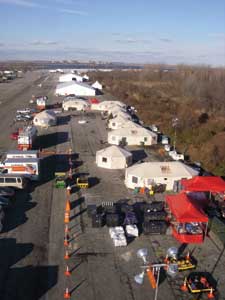 |
| An aerial shot of the FDNY IMT incident command post at Floyd Bennett Field. (Photo by FDNY IMT PIO Walter Kowalski.) |
On October 27, 2012, the Fire Department of New York (FDNY) IMT command and general staff (CGS) attended a meeting conducted by the FDNY assistant operations chief at FDNY headquarters. The meeting’s purpose was to develop with the Office of Emergency Management (OEM) an incident action plan (IAP) for 0700 hours on October 29 to remove fallen trees and debris before the arrival of the high winds. This was the first of many meetings with the other agencies that would respond to Sandy, and it was the first time this team, which was formed after 9/11, would be used by the OEM and the Mayor’s Office—the team’s first opportunity to deal with agencies not accustomed to working with an IMT or within an incident command system (ICS). By evening, we had to abandon the plan we formulated based on the objectives adopted at these meetings and develop a new one.
October 28
MISSION 1
As Sandy headed up the East Coast and started to affect the Carolinas and southern Jersey, our focus was “Homebound Evacuations.” Some team members had experience in this area (15 to 30 members were deployed), but the trainee members who would be added to bring the team to its full complement did not.
Last year prior to our deployment in Binghamton, New York, the team was deployed for the homebound evacuations for Hurricane Irene. The objective was to have nonambulatory residents in the flood zone area use the city’s 311 system to request assistance. FDNY members would assist them in boarding a Department of Education bus that would take them to an evacuation center. This process involved coordinating with emergency medical services (EMS), OEM, 311 operators, the Department of Energy, FDNY, the Department of Transportation (DOT), the National Guard, and FDNY IMT dispatchers at headquarters. Residents had up to midnight October 29 to evacuate because of the heavy winds. The safety officer considered it unsafe for the light-frame buses, the driver, and the passengers to travel in the high-wind conditions predicted. Our team, which was working out of the FDNY headquarters command center, was operating with 15 to 20 members at this point.
We would have a full team of 45 to 60 members over the next five days in one area instead of out of various offices. This mission presented team members with an opportunity to train members who had just finished some ICS classes. The PIO function had just given classes to nine members, some who had never been deployed to an incident.
Four additional PIOs assisted in this mission—three in my section and one, who was also a liaison officer, to assist the other liaison officer at OEM. This arrangement expedited the turnaround of information and assisted team functions with other city agencies. As a PIO Section, we collected data for the team and the FDNY Press Office. About 60 nonambulatory occupants were transported.
October 28-November 2
MISSION 2
The next mission was to provide for fire and life safety functions according to the Citywide Incident Management System (CIMS). It involved supporting the five New York boroughs with resources for life and safety services if the storm isolated emergency personnel and apparatus or closed streets and bridges. This was a concern since the Port Authority of New York and New Jersey was closing its bridges and the DOT was closing interior bridges because of flooding and high winds. All emergency vehicles crossing such bridges and tunnels would be doing so at their own risk.
We had to use resources to provide fire and EMS life safety operations in Category 1 “A” Flood Zone areas for search and rescue. Along with our rescue companies and Special Operations Command (SOC) support trucks, the team coordinated a dispatch and communications plan for reserve and special units. The plan called for the effective use of high-water brush fire units to support EMS operations at locations identified by EMS Command. This comprehensive plan required a full team assignment. Sixty of our 149 roster members were deployed to our already functioning command post at headquarters.
We were in a building that was centrally located to all the boroughs and had electricity, bathrooms, heat, and plenty of computers and copy machines. Many members spent the night at headquarters instead of driving—for safety reasons as well as saving gasoline, which was scarce. During the storm, we moved critical resources to high elevations. The IMT helped to coordinate more than 500 swift water boat rescues and more than 1,000 evacuations and to battle fires in higher than 60-mile-per-hour winds with the water level on the streets higher than eight feet. The IMT used brush fire units to enable EMS to get to medical emergencies and transport patients if necessary.
Once the high point of the storm had passed, the IMT used urban search and rescue (US&R) teams from FDNY, Virginia, Maryland, and Massachusetts as well as a swift water team from Binghamton. This mission consisted of knocking on doors to see if occupants needed assistance and to perform a 360° check of properties of more than 31,000 dwellings and businesses within the affected areas of Queens, Brooklyn, and Staten Island. At this time, the PIO Section was using six members. Only one other PIO was trained and available to accept the deployment; it was the first assignment for the other members. Our function as the PIO team is to disseminate information internally and externally at an incident and, at times, to watch operations take place to have a visual as well as understand the objectives of the plan. This can’t always be accomplished because of the hazards that may exist.
Media attention grew when it became known that out-of-state US&R teams responded; the media were also interested in storm stories. Our PIO team members alternated between assisting in the field and returning to the incident command post. Sometimes, PIOs were sent to parts of the city because media members were just showing up in areas without notice; we assisted them with their stories.
Many in the media became aware of the heroic efforts of the off-duty and retired FDNY members all over the city, especially in the affected areas such as the Rockaway Peninsula of Queens. One nightly news channel heard of people being saved from burning buildings, being picked up by swift water boats, and the stopping of a fire down a street because an engine chauffer went underwater to hook up to a hydrant. The challenge was finding the firefighters, officers, and chiefs that night to cover the story. We had to call these members and interview them over the phone; in some cases, these parties weren’t part of the rescue or weren’t sure of the person who had made the rescue. As each PIO worked to gather this information, he had to write it down for the FDNY Press Office to review and record.
The staff had put together all these stories. We were handling this role because FDNY field units (extra ladders, engines, rescue, and swift water boats) were in our IAP as resources and were functioning under our operations the night of the storm. For the story to hit the news at night, we had to have background interviews of firefighters; video footage would make it better. We were e-mailed video that some on- and off-duty FDNY members had taken that night. Our Safety Command, when we inquired about some of these incidents, saved and extracted radio recordings off the department’s tactical recording devices. To make sure the story was covered accurately, not only were PIOs present for every interview, but I also went to NBC studios to deliver the sound recordings of radio transmissions of the night of the storm from FDNY Safety Command at 4:30 p.m. The story was to air that evening; we were in Brooklyn, and the studio was in Manhattan.
At the studio, an officer from Safety Command and I were able to listen to the recordings and pair them with the appropriate story because they were featuring two rescues in two different parts of the Rockaways. The story and editing were completed at 6:15 p.m. for the 6:30 p.m. show. This was the first time the FDNY IMT covered a story from beginning to end with the approval of the FDNY Press Office.
As a PIO section, we provided our team, FDNY staff chiefs, firehouses, EMS chiefs, and all officials who requested them our updates. We were writing two updates per day, one for an internal audience and one for an external audience; the latter included safety messages such as warnings about the dangers of carbon monoxide when using generators. The FDNY Press Office allowed our section to set up and conduct most media matters in the affected areas. Because the team was under the supervision of the FDNY, not many clearances were needed for the news stories. This changed and became challenging in the coming weeks and month.
November 1-December 29
MISSION 3
As the second mission was coming to a manageable stage for the FDNY, the IMT was assigned to assist communities recovering from the storm damage by coordinating tree removal and dewatering operations. These actions would ensure that all streets would be passable and would assist the Department of Parks as it received calls for trees down. The IMT worked in conjunction with the OEM task forces and the 911/311 reporting system. The mission, which included pumping water out of residential basements, necessitated another full team to supplement the FDNY with 145 fire personnel, 25 rapid response vehicles (a box truck containing tools and equipment to support rescue companies), two additional ladder companies, and two additional engine companies. At the time this article was written, approximately 3,500 trees were removed; more than 2,700 basements were dewatered; and some 250 streets filled with beach sand were washed down.
The PIOs continued their functions, meetings, and attendance at each morning conference call with teams’ command and general staff along with FDNY borough commanders, FDNY operations chief, and other staff chiefs. We also continued to follow up and provide information for media interest and e-mail and print two updates of the mission. This incident was giving the PIOs the opportunity to put their ICS training to good use. It was also allowing them to see the challenges an all-hazard team in a big city would face, including fuel, rental cars, and having to cover such a large area with a short time of daylight operations.
It is always important that the lead or an assistant keep in contact with the PIOs throughout the day for safety reasons. Personnel safety is key and a part of the department’s and the fire service’s core values. Here on the East Coast, the sun was setting around 4:20 p.m. or so, and it was becoming dark before 5:00 p.m. On incidents with no nighttime operations, the PIO should always make it back to the command post before dark. But many in the media in the city need to do stories at 5 p.m., 6 p.m., 7 p.m., 9 p.m.,10 p.m., and 11p.m.—and then there are the early morning shows. The tendency is to do live shots on scene as well. The media interest in New York can be large.
Since this mission could now be managed by borough chiefs, the IMT switched from a full team to a partial team. This enabled members to get some needed rest and would allow those personally affected by the storm to return home and start to do their own dewatering and gutting. We held an After Action Review to go over some lessons learned and what we thought would help the next deployed team. This meeting proved to be effective because we didn’t even get to unpack our bags before the city asked us to undertake another mission.
November 24-December 29
MISSION 4
On November 23, while I was taking one of my required days off, my incident commander called and asked me to report to the OEM for a briefing about another mission. This mission involved a full team deployment of 60 members to assist the OEM and the Mayor’s Office. We were to meet at the old Floyd Bennett Field, which was being used as a staging area by the National Guard, the Federal Emergency Management Agency (FEMA), the New York Police Department, and a host of other agencies. Our Logistics Section went to the FDNY cache and transported everything we had purchased over the past 10 years—office tents, generators, lights, mobile command center, planning vehicle, computers, mobile phones, and every piece of equipment down to a stapler. The reason for moving the operations from headquarters was that team members for Mission 1 and 2 were at times traveling an hour to get to the affected areas because of traffic and refueling. This new location enabled team members and resources to return to the command post at a time when it was safer to travel and to arrive less tired.
Our new mission was the “Support to Residents in their Homes” wellness initiative. We were to create and maintain an organized field outreach program to residents in affected areas that addressed the Department of Health and Mental Hygiene (DOHMH) wellness initiatives, develop a logistical deployment plan for distributing designated material and commodities, and disseminate internal and external information of the public’s needs and concerns during the city’s recovery under the guidance and approval of the Mayor’s Office. We would gather the data through a door-to-door assessment of the affected areas, identify and train participants from city agencies in the IMT positions, and assist the NYC OEM in coordinating the DOHMH in this initiative.
Our first operational period began at 0800 hours on November 26. The team had to manage from 250 to 650 resources in an operational period. The volunteers and resources were from various city agencies as well as the National Guard of NY, FEMA, OEM, FDNY, Disaster Medical Assistance Team, and Americorps. The data consisted of information on things like running water, immediate medical issues, the filling of prescriptions, food, heat, electric, sewage working, and any other life-critical needs. The information was recorded on paper at the beginning of the mission. The Guard collected the papers at the end of the work period and presented them to Operations, which passed them on to DOHMH. There was a four- to five-day turnaround, and some visits had to be repeated.
To expedite and ensure accuracy, technicians from the Mayor’s Office devised a program that secured personal information and immediately updated it for distribution to the appropriate agencies. Since the PIO section was updating data on what occurred during that operational period for an OEM representative who needed it for an early evening conference call, every day at 1530 hours, PIO staff members went for information to the leaders of Operations, Plans, and, most importantly, the Situational Report (a function in the planning section that collects data for the incident and gives current and projected weather forecasts). We worked with the Situation unit leader to gather this information to meet the 1630 hour update deadline. The PIOs then used that information and any updates from the Situation unit report to create a morning report.
While gathering data, the National Guard, Americorps volunteers, and team members distributed items the residents needed such as ready-to-eat meals, sanitary kits, water, blankets, electric blankets (given only to residents with electric power, not those on generators), respiratory masks, and heaters.
The PIO function included also “traplines,” areas where people may gather and get information, such as evacuation centers, firehouses, parking lot distribution centers, and churches. City and federal information that would benefit the public; fire prevention educational information; and safety tips related to generators, space heaters, and candles were put into a packet and distributed through the traplines. We had placed more than 24,000 pamphlets. PIOs monitored the information closely to determine when the literature had to be revised (with the approval of the appropriate agency or ranking officer). As the PIOs were asked questions on the traplines, the questions were passed on to the OEM, which obtained answers from the agencies responsible for the service.
As the objectives were being met over the coming weeks and the OEM plan was proving successful, the team, which was serving on its longest deployment to date, turned its focus to the rest-to-work ratio. Section chiefs were asked to ensure that their members’ ratio was being met. Many members in my section started rotating days off. The city’s objective was to get other agencies trained in ICS. We had seven PIO trainees from FDNY, one from Hawaii EMAC, one from FEMA New Mexico, one from the NY Parks Department, one from NYC Human Resources Administration, and one from OEM; the team began training 16 personnel from outside agencies in its deployment. In the affected boroughs at the time of our demobilization, the volunteers and the National Guard had placed with residents more than 29,000 fire prevention brochures; 6,395 blankets; 4,540 electric blankets; 3,577 cases of water; 42,922 meals; 764 cases of masks; 4,191 comfort kits; and 931 portable heaters. They visited 100,000 dwellings in 46 days.
SEAN JOHNSON has been a member of the Fire Department of New York (FDNY) since 1998; he is assigned to a ladder company and works for Safety Command for the chief of safety. He is the lead public information officer for the FDNY Incident Management Team. He is a certified accident investigator and a fatal fire investigator for the FDNY and a nationally certified Fire Department Safety Officer Association incident safety officer. He is a National Incident Management System-certified instructor for public information courses and an all hazard liaison officer.
FDNY Incident Management Team
BY DANIEL P. SHERIDAN
In the days leading up to Superstorm Sandy, the local news stations and newspapers were warning people in the tri-state area (New York, New Jersey, and Connecticut) to be prepared for a possible Category 1 hurricane. Hurricanes are not frequent occurrences in this part of the United States, so it seems that most people were just not prepared for the devastation to come. Just a year before, New Yorkers were given the same dire warnings for Hurricane Irene, and it didn’t hit as hard as predicted. Most people thought the same thing was going to happen with Sandy.
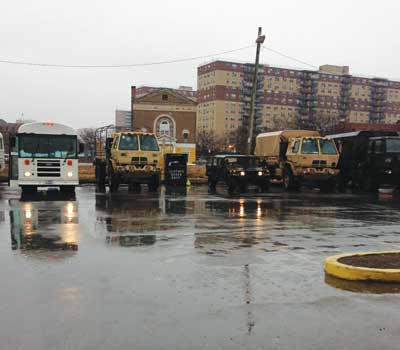 |
| (1) National Guard trucks at the Rockaway command post. (Photos by author.) |
In addition to my normal duties as a battalion chief in the Fire Department of New York (FDNY), I am also part of the FDNY Incident Management Team (IMT). The IMT is a Type 2 All Hazard Team. The team was born as a result of the World Trade Center attack on September 11, 2001. The department realized after that event that it needed a team that could manage large catastrophes within our city.
THE TEAM
The IMT consists of five sections:
- Finance
- Logistics
- Operations
- Planning
- Command
Team members are constantly training. It is normal to find members out west shadowing national teams, such as the Southwest Team, during the summer months. FDNY IMT members work side by side with members of national teams, learning the tricks of the trade. I have been out twice on wildfires shadowing division supervisors. The training received on these assignments was invaluable. We were able to see firsthand and learn from the best in the business that the incident command system (ICS) works very well.
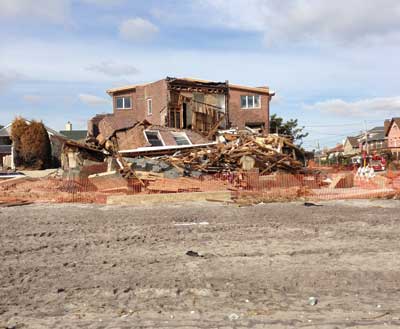 |
| (2) This house in Rockaway, Queens, was totally destroyed. |
Our first deployment as a team was in 2005 when the FDNY deployed 300 officers and firefighters, as well as the FDNY IMT, to New Orleans for Hurricane Katrina. At the time, I was a captain working in an engine company and was not part of the IMT. We went down to New Orleans to assist the overwhelmed New Orleans firefighters, who were dealing with their own personal tragedies as well. The FDNY would learn firsthand what this was like because approximately 800 of our members were affected by Sandy.
The FDNY IMT was again deployed, in August 2007, as a team to the East End Complex in Idaho to assist National Incident Management Organization (NIMO) teams to work a wildland fire. There, the team took on the various roles of an IMT. I was assigned as a division supervisor, and it was there that I really got a good feel for the system and how it works. All these deployments and training exercises paid off big when we were confronted with the aftermath of Sandy.
SANDY
I was home on the night Sandy arrived. I live approximately 60 miles north of New York City (NYC). I was hunkered down in our house, prepared for the worse. Outside my house, the wind was howling as I had never heard it before in the 23 years I have lived there. Trees were falling like twigs. We lost power very quickly, so I had no idea of what was happening in NYC. I received a call that night, notifying me that the FDNY was activating the IMT.
I was ordered to report to Queens. The 13th Division had set up a mobile command post in Howard Beach. When I got there at 0600 hours, the chiefs and officers were overwhelmed with reports of people trapped in their homes by the floodwater. There had been three major fires in the Rockaways the night before. One of the fires took out approximately 110 homes in the Breezy Point section of Rockaway. The other two fires were within a mile of each other. The fire in Belle Harbor took about 20 homes and a landmark restaurant. The third fire was in a row of stores on Rockaway Beach Boulevard. The firefighters had to deal with the flood, numerous people trapped, and the fire.
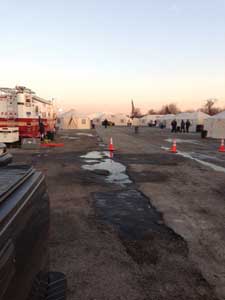 |
| (3) The base camp. |
The IMT used the FDNY Fire Department Operations Center (FDOC) as its base of operations. The FDOC is the nerve center for the FDNY. Each one of the five sections took over a small portion of the FDOC’s main meeting room. We needed to put together a plan that would help the FDNY manage this major catastrophe. Three major areas of NYC were affected:
- Queens: the Rockaway Peninsula, Howard Beach.
- Brooklyn: Coney Island, Canarsie, Gerritsen Beach, and Red Hook.
- Staten Island: all of the South Shore and a small part of the North Shore.
The IMT set up three branches. Within the branches were sectors and within the sectors were task forces comprised of the following:
- Urban search and rescue (US&R) teams.
- FDNY Rapid Response Vehicles (RRVs).
- Special Operations Command (SOC) support trucks.
The goal was to check every location within the affected areas for missing persons, hazardous conditions, and building stability. It took about a week to check every residence. After a few days, the water subsided in most places, but we still had a few areas—for example, Midland Beach in Staten Island—that had a lot of water in the streets. The main difference I saw between Katrina in New Orleans and Sandy is that because New Orleans is below sea level, the water stayed around much longer. The storm surge in NYC, for the most part, came in and out quickly, but it left a tremendous amount of damage in its wake.
After we finished with that assignment, the IMT put together a small team to help with the cleanup in the Rockaways. The city asked the FDNY IMT to put together task forces that could get rid of all the sand that was clogging the storm drains on the Peninsula. A second task force was assembled to pump out people’s basements, mostly in Breezy Point. The IMT put together an incident action plan every day for about a month. The sand cleanup equipment consisted of the following:
- Four reserve engine apparatus
- One skid loader
- One front-end loader
- One dump truck
- One Department of Environmental Protection storm basin truck (Clamshell)
- One vacuum truck
The task force assigned to pump out basements was comprised of RRVs. They are the second piece of the SOC support ladder trucks. They carry selected tools that normally wouldn’t fit on the apparatus but are needed to assist in emergencies such as collapses, down trees, and trench rescues, to name a few.
Although it didn’t seem to be glamorous work, the people in the Rockaways were extremely appreciative of the FDNY’s commitment to help restore normalcy to their lives. Besides the members who were working the IMT, there was a whole army of firefighters spending their off-duty time volunteering in any way possible. The firefighters took it upon themselves to form into groups; they would spend hours cleaning up and pumping out people’s houses. One group formed a nonprofit organization and organized hundreds of volunteers to work on people’s houses at no cost to the owners.
The final phase of the IMT’s commitment came on November 24, right after Thanksgiving. The Mayor’s Office, through the NYC Office of Emergency Management asked the FDNY if it would take charge of “Operation Anti-Freeze.” The Mayor’s Office was concerned about the impending cold weather, which would endanger the many people without power or heat. The IMT was given the following assets to accomplish this mission:
- The New York Army Reserve National Guard.
- Americorps (a group similar to the Peace Corp) that works domestically.
- The Federal Emergency Management Agency (FEMA).
- Disaster Medical Assistance Teams (DMATs).
The mission’s incident objectives were as follows:
- Provide for the safety of the responders and the public.
- Coordinate the collection, dissemination, and feedback of incident data with other involved city agencies.
- Identify and train participants from city agencies in the IMT positions.
- Maintain an organized field outreach program and commodity distribution system to residents in affected areas to support basic life-sustaining needs while sharing information concerning the nature and availability of city and federal programs.
- Disseminate internal and external information of the public’s needs and concerns during the city’s recovery under the guidance and approval of the Mayor’s Office.
To put things in layman’s terms: The IMT was to go out and knock on every door in the affected areas and find out who was in trouble. We found plenty of people in bad shape. We were able to offer them electric heaters, food, water, and medical care. The ultimate goal was to get the residents to a NYC Restoration Center. The center was a great idea; it was a place where affected residents could get information and enroll in programs such as the NYC Rapid Repair Program, a city-run program backed by FEMA under which homeowners affected by the storm could obtain at no cost a boiler, electrical work, and mold mitigation. The center had representatives from FEMA with whom the citizens could register. A good analogy of what the centers were all about is a mall or a one-stop shopping center where people could get all the help they need in one place.
In the beginning days of the operation, the soldiers and volunteers would canvass the affected residents and record all the information on a printed form. After a few days, someone from the Mayor’s Office had a brilliant idea—create an app that could be put on a mobile handheld device that would replace the form and all that unnecessary paper. One of the task forces tried the idea; it was found to be successful. After a while, the tablets became the norm, and the forms became a backup.
The FDNY IMT worked for approximately five weeks. It transferred command to the Lone Star (TX) IMT, headed by Paul Hannemann, on December 29.
It is tough to measure success in an unprecedented operation such as this. The FDNY IMT performed above and beyond expectations. Who knows how many lives were saved? For example, there was a family living in a house that had no heat and electricity. The family had somehow rigged extension cords from a neighbor’s house and a plastic tube from the gas main to supply an illegal heater to a living room loaded with combustibles. Team members discovered this situation on a routine canvass of the area. The people in the house had no idea of the danger in which they had placed themselves. We were able to convince them to go to a center, where the city would make arrangements to place them in a temporary housing unit. We were able to contact the utility company and resolve the dangerous situation.
This is just one example of the many hazardous situations we encountered in our mission to make sure not one person would be unaccounted for. We found numerous cases of people storing flammables in unsafe containers; some of these containers were found indoors. There were homes where fumes from generators were creating high levels of carbon monoxide. We estimate that we conducted and completed 92,000 surveys of residents in the affected areas four times (targeted addresses three times and door-to-door visits of all addresses once). More than 500 electric heaters were distributed along with thousands of blankets.
It was established that the FDNY IMT has the capabilities to handle anything that may come our way if calamities or disasters should befall NYC in the future. All the training and planning pay big dividends when a calamity happens. The National Incident Management System or, in our case, City Incident Management System is the only way to handle large events such as hurricanes. The ICS works; we are the proof.
DANIEL P. SHERIDAN is a 26-year veteran of the Fire Department of New York, where he is a battalion chief. He has worked in the highly active units in Harlem and the Bronx for most of his career. He is a national instructor and the founder and chief operating officer of Mutual Aid Training Group, an international nonprofit training group to assist firefighters. Previously, he instructed at the Rockland County (NY) Fire Academy. He is a frequent contributor to Fire Engineering and has a monthly column on FireEngineering.com. He authored Chapter 12 (Forcible Entry) for Fire Engineering’s Handbook for Firefighter I and II.
Fire Engineering Archives

